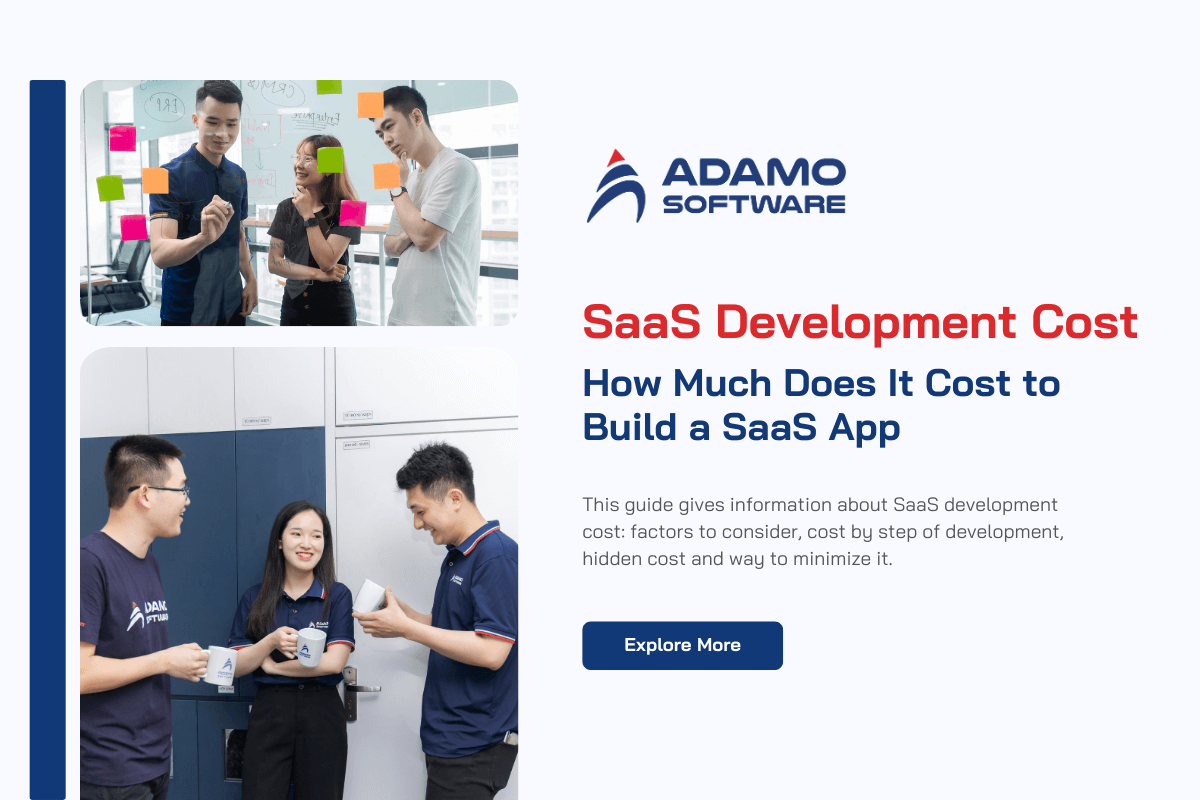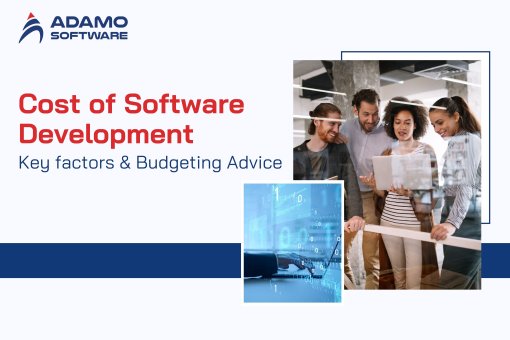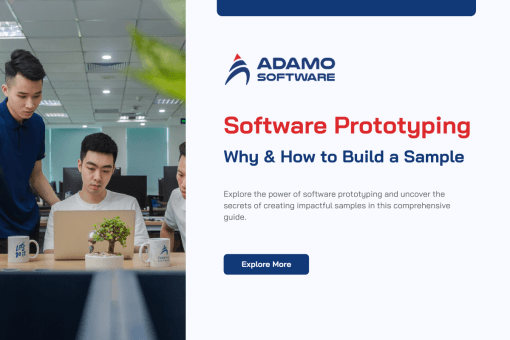SaaS Development Cost: How Much Does It Cost to Build a SaaS App?

This guide gives information about SaaS development cost: factors to consider, cost by step of development, hidden cost and way to minimize it.
Building a SaaS application, like any other solutions, requires money, and it can be quite expensive.
By now, you probably realize that determining the actual SaaS development cost is a bit tricky. But don’t worry, we have you covered.
This article provides answers on how much it costs to build a SaaS application.
We offer a detailed breakdown of SaaS app costs, the factors influencing those costs, and tips for starting a SaaS application on a budget.
Now, let’s get started.
I. Which Factors Affect SaaS Development Cost
We all know that the cost of developing a SaaS platform involves more than just a simple number. It’s a crucial aspect that every business owner must understand from the start. Let’s explore the main factors influencing SaaS development cost in detail.
1. Scope of Work & Business Logic Complexity
The complexity and scope of a SaaS project can significantly affect its cost.
SaaS applications are extensive, with many features, functions, and uses. Building a SaaS platform is complex and time-consuming. It needs a sophisticated tech stack and a skilled development team to bring your vision to life.
Projects with complex features, such as extensive user processes or large-scale implementations, typically require more time, resources, and expertise, leading to higher development costs.
The number of users you plan to target and the variety of products or services you want to offer also influence the SaaS development cost.
There are four common levels of SaaS application complexity:
_ Micro SaaS: $15,000 to $25,000
_ Basic SaaS: $25,000 to $50,000
_ Medium SaaS: $50,000 to $150,000
_ Complex SaaS: $150,000 to $500,000
It is advisable to start by building a scalable MVP for the SaaS platform. This can help you save on high startup costs.
2. SaaS Application Types
SaaS development cost estimation also depends on the category or type of your application. Different SaaS applications have varying development requirements; some require extensive time and effort to build, while others can be integrated easily with basic coding.
Here is a breakdown of the costs based on the type of SaaS solutions:
| Types of SaaS Solutions | Average MVP Price (USD) | Popular Solutions |
| Accounting | $70,000 – $80,000 | QuickBooks |
| CMS and E-Commerce | $100,000 – $150,000 | HubSpot |
| HRM Solutions | $10,000 – $100,000 | Oracle Fusion Cloud HCM |
| Email Marketing | $60,000 – $70,000 | Mail Chimp |
| ERP | $110,000 – $120,000 | NetSuite |
| Project Management | $60,000 – $70,000 | Confluence |
| Communication Platform | $10,000 – $100,000 | Microsoft Teams |
| Payment Gateways | $70,000 – $100,000 | Braintree |
3. SaaS Application Features
The features your SaaS app needs depend on the specific requirements. If it’s a simple tool focused on one area, starting with basic features is sufficient. However, more complex platforms with broader scopes may require additional functions.
Here are some key features that almost any SaaS app should include:
User management
User management features for SaaS apps should include user registration, login, logout, and editable profiles. Users should also be able to reset and change forgotten passwords.
For permission management, include options to add and remove users, and implement role-based access to control the abilities of different users.
Consider multi-tenancy. The more users and roles your SaaS product support, the more complex the user management and permission features become. Some solutions require multiple permissions and access control levels, such as read-only, edit, and admin options. However, this complexity can increase the SaaS development cost.
Analytical tools
A third of all SaaS purchases involve solutions with AI features, especially for quality analytics.
Most users need access to data analytics, metrics, charts, and graphs. For business intelligence applications, a dashboard is essential. Your SaaS app should provide users with reports, track real-time changes, and send notifications.
Including analytical tools impacts the price in several ways:
_ Developing analytical tools requires expertise in data collection, analysis, and visualization.
_ Extensive data collection and analysis, especially in marketing or finance, need advanced tools that are more expensive to develop and maintain.
The quality and accuracy of analytical tools, particularly those using AI/ML technologies, add to the budget.
Data quality significantly influences your SaaS product’s user experience and market appeal. Investing in high-quality analytics is crucial.
Data security
Data security and compliance are vital, accounting for half of the top ten purchases made by SaaS companies for custom solutions.
Your app may need audit trail and security functions to prevent unwanted activity and control the environment. Since SaaS applications usually provide data, services, and cloud storage for many users, trustworthiness is essential.
SaaS solutions handling sensitive data, such as financial or healthcare information, require advanced security measures, which can be more costly to develop and maintain.
Communication
Users often want to chat, receive notifications, or have voice and video calls. Document storage and sharing are also common features.
You may include messaging or email functionalities within the system, integrating with email service providers if necessary.
Billing management
This feature is necessary to display payment history and manage successful and unsuccessful charges. Using an external hosting service can simplify handling this data.
Account management tools help control subscriptions, including upgrades, downgrades, deleted accounts, billing failures, and other important metrics.
4. Tech Stacks and Integrations
The tech stack also affects SaaS development cost. Some technologies or frameworks may require specialized expertise, licensing fees, or extra development time.
For example, in 2023, Zig is the highest-paid programming language with an average salary of $103,611, while Java, a popular language, has an average salary of $72,701 (according to Stack Overflow).

Moreover, integrating the SaaS app with third-party services or building APIs for integration with other systems can increase development costs. The complexity and number of integrations required will impact the effort and resources needed.
Choosing ech stack and the list of integrations depend on the specific project requirements. To simplify this process, consider getting support from a software development vendor. They can help you select the appropriate tech stack for your SaaS product.
III. SaaS Development Cost: How to Estimate
Software development stages also play a vital role in estimating the cost of developing a SaaS product. Each phase defines the time and cost, contributing to the final SaaS development cost.
Let’s go through each phase to understand the cost calculation properly:
1. Discovery and Planning Phase
Before starting SaaS development process or hiring a team, you need to finalize your product ideas. You should have a clear understanding of your business objectives and how the idea can benefit or be competitive.
Ensure that your idea is validated and can bring significant benefits to your business. Conduct comprehensive research and gather customer feedback. So that you can define the roadmap for SaaS application development.
This phase is crucial when starting a SaaS company and typically takes 1-3 weeks.
You should also care about building an MVP version. This helps you implement and validate your ideas and build a product with basic features.
The estimated SaaS development cost for this phase is $2,000 – $7,000.
2. UX/UI Design
UI/UX design is also an important stage in SaaS product development. This phase determines how your application will look and how users will interact with it.
During this phase, UI/UX designers focus on creating an intuitive and user-friendly interface for the SaaS solution. Their goal is to foster engagement and encourage users to interact frequently with the platform. They design every element, from navigation menus to interactive components, to ensure a seamless and enjoyable user experience.
UI/UX development typically takes around three to four weeks to complete.
The average cost for UI/UX design is about $5,000 to $10,000.
3. SaaS Development Phase
SaaS solutions use various frameworks, libraries, and development tools within their complex architecture, which includes front-end and back-end development.
Front-end Development
Users take just 50 milliseconds to decide whether to continue using your application, and many will leave if the initial impression is poor. Front-end development helps you choose the right tech stack based on core features.
The cost of developing a SaaS front-end is hard to predict due to various factors. Front-end development isn’t just about creating a great design; it also involves file compression, caching, lazy loading, optimizing images, and reducing server calls.
Experienced front-end developers are essential for this task. Hiring software outsourcing development partners rather than freelancers is often the best way to connect with expert developers.
The average rate for front-end developers is between $35-$80 per hour, with total costs ranging from $10,000 to $40,000.
Back-end Development
Back-end development is a major phase where costs are typically higher. Back-end developers must create every module and functionality from scratch. However, using APIs can help reduce costs. Key functionalities might include push notifications, database management, security, file management, search, export, and user queries.
Building the back-end of your SaaS application usually takes around 20 to 25 weeks. With an average developer rate of $30 to $70 per hour, the cost can range from $18,000 to $60,000.
Also read: The Role of DevOps in SaaS Application Development
4. QA Testing
Remember that Quality assurance is also an essential part of custom software development for a SaaS product. This phase costs range from $5,000 to $15,000.
5. Application Maintenance
Support and maintenance are critical factors in SaaS development cost. The monthly cost for a small team of developers, designers, and quality assurance engineers ranges from $10,000 to $20,000. Hosting fees typically vary from $1,000 to $10,000 per month.
Operations must adhere to project requirements, service-level agreements, security regulations, and the common infrastructure of cloud services.
Wrap-up cost estimation in the below infographic:

IV. Hidden Cost of SaaS Development Project
You may not be overly concerned about these expenses during the initial stages of building a product. But the total ownership cost must include two significant hidden expenses of SaaS product development.
Let’s examine each in more detail:
1. Ongoing maintenance
Ongoing maintenance accounts for 25% of the cost of developing SaaS software. If the development cost is $100,000, the annual maintenance cost might be around $25,000.
Maintenance expenses include:
_ Hosting
_ Domain name
_ SSL certificate
_ Email services
_ Superior technical support
These costs are essential to keep your platform running smoothly and to provide immediate fixes for any issues.
2. Marketing and promotion
Marketing is important if you want to expand your user base and achieving business objectives. If the development cost is $100,000, you should budget at least $200,000 to $300,000 per year for product promotion. The high yearly cost of marketing includes:
_ Information architecture
_ Technical on-site and off-site SEO
_ Email marketing
_ Product hunt releases
_ Social media marketing
V. How Much Does It Cost to Build a SaaS Application by Hiring a Software Development Partner
Software outsourcing development companies usually cost more than hiring freelancers, but they offer many benefits.
First, these companies are often more experienced because they’ve handled many projects, especially those specializing in SaaS. They also have more organized processes.
They can manage themselves, so you won’t need to closely oversee an individual developer’s work. They typically assign a project manager to handle the development team and communicate with you.
This is helpful for entrepreneurs without experience in managing software development or busy entrepreneurs.
However, notice this: Hiring SaaS application development in the USA or Canada is the most expensive. And prices are lower in Western and Eastern Europe, and the cheapest options are in Southeast Asia or South America.
Hourly Rate Comparison in Different Regions
| Country | Hourly Rates | Countries |
| Eastern Europe | $30-$50 | Ukraine, Romania, Poland, Bulgaria, Hungary, Czech Republic, Slovakia, Belarus |
| Latin America | $30-$50 | Argentina, Brazil, Mexico, Colombia, Peru, Chile |
| Africa | $20-$45 | South Africa, Morocco, Kenya, Nigeria, Egypt |
| Asia | $15-$40 | Vietnam, India, China, Indonesia, Philippines, Pakistan, Malaysia, Bangladesh |
VI. When You Should Outsource Your SaaS Development to a Third Party
In some cases, outsourcing SaaS development can help you reduce your SaaS development cost. Consider choosing this service if:
_ You’re not technical or don’t have time to manage the project yourself.
_ You need expert help to create a detailed plan for your SaaS.
_ You want a project manager from the agency to oversee and communicate about your project.
_ You need a fast launch since agencies can assign multiple developers to your project.
_ You want everything in one place: planning, design, development, and more.
_ You need quality assurance to ensure the software is secure and reliable.
_ You need more guidance through the SaaS development process.
_ You have the budget to pay for agency rates, which are usually higher.
VII. 4 Tips to Minimize SaaS Development Cost
Developing a SaaS product can be expensive, but there are ways to cut costs whether you’re a startup or a large company. Here are some tips to help you save money:
1. Build an MVP (Minimum Viable Product)
Taking too long to develop your SaaS might increases costs. Instead of building a fully-featured product from the start, create an MVP with basic features and launch it can reduce costs and time-saving. This way, you can start making sales and use that revenue to add more features later.
2. Consider Outsource SaaS Development
Hiring in-house developers can be pricey, especially for start-up. Consider outsourcing Saas development to dedicated teams in more affordable countries like Vietnam, India, or the Philippines, which are much cheaper than hiring in the North America countries like US or Canada.
You can gain more insights into Outsourcing SaaS Development in our dedicated blog.
3. Use Third-Party Services
Another tip is that you can save your time and money by integrating third-party APIs for common features like login, payment processing, and subscription management.
As there’re now a number of third-party service providers, it’s really easy to find appropriate one for your SaaS application.
4. Consider Shared Hosting
Shared hosting is cheaper than individual hosting plans. Use shared hosting until your user base grows. If you need individual plans, select a provider that offers customizable plans to manage costs.
VIII. Why Choose Adamo Software as a Trustworthy SaaS Development Vendor
Adamo Software has delivered over 120 successful projects of SaaS development in various fields, including:
_ Travel & Hospitality
_ Media & Entertainment
_ Fintech
_ F&B
_ Retail & eCommerce
_ Edtech
Our experience helps reduce the overall SaaS development cost, saving you time and money.
Need a custom SaaS solution? Our team can build a SaaS product from scratch, tailored to your specific business requirements and needs.
Contact us today to discuss your requirements with our team.











